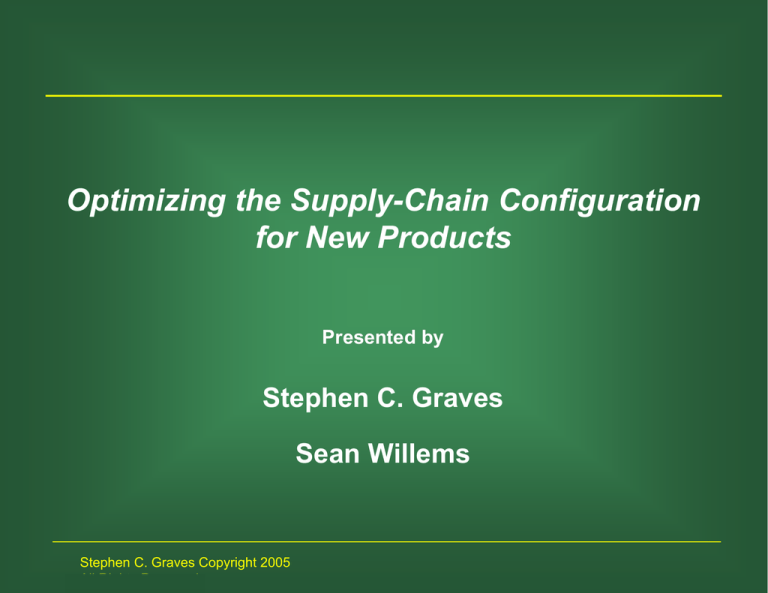
Optimizing the Supply-Chain Configuration
for New Products
Presented by
Stephen C. Graves
Sean Willems
Stephen C. Graves Copyright 2005
All Rights Reserved
Talk Outline
• Problem definition
• Current practice
• Digital camera example
• Comparison of solution approaches
• Observations
• Next steps
Stephen C. Graves Copyright 2005
All Rights Reserved
Sourcing Optimizer Motivation
• How to configure a new product’s supply
chain?
- Various vendors can supply a raw material
- Multiple processes can produce assembly
• Two vendors can deliver an identical
product. Which one do you pick?
- A quotes 100 days at $1.00 per unit
- B quotes 3 days at $1.10 per unit
Stephen C. Graves Copyright 2005
All Rights Reserved
Relevant Supply Chain Costs
• Cost-of-goods sold
• Safety stock cost
• Pipeline stock cost
• Time-to-market cost
• Quality cost
• Capacity and flexibility cost
Stephen C. Graves Copyright 2005
All Rights Reserved
Current Practice = Target Costing
• Market price set outside the design group
• Gross margin for product is set
• This dictates product’s maximum unit cost
• Maximum unit cost bounds UMC
• UMC is then allocated to subassemblies
- Having established target UMC, designers
independently source their portion of the supply chain
Stephen C. Graves Copyright 2005
All Rights Reserved
Current Practice
• Numerous factors to consider when choosing
options
- Functionality, price, quality, flexibility, etc
- Firm establishes minimum thresholds for each factor. Chooses
minimum cost parts and processes among qualifying set
• Justification for current approach
- Other factors are difficult, if not impossible, to quantify
- UMC will dictate whether or not product’s business case is
successful
- Design team is not the same team that has to live with the options
selected
Stephen C. Graves Copyright 2005
All Rights Reserved
Sourcing Optimizer Problem Statement
• Define a supply chain configuration as the
set of options selected for each stage in
supply chain
• Stages include procurement; production,
assembly and test processes; distribution
channels; and transportation modes
• Intent: develop a DSS for determining
options in SC configuration, given a stable
product design
Stephen C. Graves Copyright 2005
All Rights Reserved
Digital Camera Example
• Pro-sumer model
- Annual demand has a mean of ~4750 units and a
standard deviation of ~145
• Three major subassemblies
- Imager
- Circuit board
- Camera body
• Two customer markets: US and export
Stephen C. Graves Copyright 2005
All Rights Reserved
Digital Camera Supply Chain
Stephen C. Graves Copyright 2005
All Rights Reserved
Digital Camera Options
Component/Process
Description
Raw Silicate
Wafer Pkg. and Test
CCD Assembly
Miscellaneous Components
Parts w/ 8 Week LT
Parts w/ 4 Week LT
Stephen C. Graves Copyright 2005
All Rights Reserved
1
2
1
2
1
2
1
2
1
1
2
3
4
1
2
3
Note: All data
has been disguised by scaling
Wafer Fab
Option
Product.
Time
Cost
60
$5
20
$8
30
$800
8
$825
10
$200
5
$225
5
$200
2
$250
30
$200
40
$105
20
$108
10
$109
0
$110
20
$175
10
$177
0
$179
Digital Camera Options
Component/Process
Description
Parts w/ 2 Week LT
Parts on Consignment
Circuit Board Assembly
Camera Body
Accessory Processing
Local Accessory Inv.
Camera Assembly
Central Distribution
US Demand
Export Demand
Stephen C. Graves Copyright 2005
All Rights Reserved
Option
1
2
1
1
2
1
2
1
1
1
2
1
1
2
1
2
Product.
Time
Cost
10
$200
0
$203
0
$225
20
$225
5
$300
70
$650
30
$665
40
$100
10
$60
6
$420
3
$520
5
$180
5
$12
1
$25
11
$15
2
$40
Three Solution Approaches
• Minimize unit manufacturing cost
• Minimize production time
• Minimize supply chain costs
Stephen C. Graves Copyright 2005
All Rights Reserved
SC Configuration Model
• Based on strategic inventory placement
model, Graves and Willems (1998)
• Assumes bounded demand, fixed and
guaranteed service times, deterministic
lead times, periodic review base-stock
control
• Supply chain configuration solved as DP
with 2-dimensional state space
Stephen C. Graves Copyright 2005
All Rights Reserved
Solution Comparison
COGS ($MM)
Inventory Cost ($MM)
Total Configuration
Cost ($MM)
Unit Manufacturing
Cost
Current
Policy
Min
UMC
17.85
1.22
19.07
17.85
1.16
19.01
Min
Prod
Time
19.4
0.6
20.0
$3,756
$3,756
$4,078
Min SC
Costs
18.02
0.85
18.87
$3,794
Length of Longest Path 127 dys 127 dys 45 days 118 dys
Stephen C. Graves Copyright 2005
All Rights Reserved
Digital Camera Options
Component/Process
Description
Raw Silicate
Wafer Fab
Option
1
2
1
Wafer Pkg. and Test
1
CCD Assembly
1
Miscellaneous Components
Parts w/ 8 Week LT
1
1
2
3
4
1
2
3
Parts w/ 4 Week LT
Stephen C. Graves Copyright 2005
All Rights Reserved
Product.
Time
60
20
30
8
10
5
5
2
30
40
20
10
0
20
10
0
Cost
$5
$8
$800
$825
$200
$225
$200
$250
$200
$105
$108
$109
$110
$175
$177
$179
Digital Camera Options
Component/Process
Description
Parts w/ 2 W eek LT
Option
1
2
Parts on Consignment
1
Circuit Board Assembly
1
2
1
Camera Body
2
Accessory Processing
1
Local Accessory Inv.
1
Camera Assembly
1
2
Central Distribution
1
1
US Demand
2
1
Export Demand
2
Stephen C. Graves Copyright 2005
All Rights Reserved
Product.
Time
10
0
0
20
5
70
30
40
10
6
3
5
5
1
11
2
Cost
$200
$203
$225
$225
$300
$650
$665
$100
$60
$420
$520
$180
$12
$25
$15
$40
Role of Holding Cost
Raw Silicate
Wafer Fab
Wafer Pkg. and Test
CCD Assembly
Miscellaneous Components
Parts w/ 8 Week LT
Parts w/ 4 Week LT
Parts w/ 2 Week LT
Parts on Consignment
Circuit Board Assembly
Base Assembly
Accessory Processing
Local Accessory Inv.
Digital Capture Device Assembly
Central Distribution
US Demand
Export Demand
Stephen C. Graves Copyright 2005
All Rights Reserved
15%
1
1
1
1
1
1
1
1
1
1
2
1
1
1
1
1
1
30%
1
1
1
1
1
3
2
1
1
1
2
1
1
1
1
2
2
45%
1
1
1
1
1
4
3
2
1
1
2
1
1
1
1
2
2
60%
1
2
1
1
1
4
3
2
1
1
2
1
1
1
1
2
2
Inventory Investment and UMC
Interaction
Initial Investment UMC
($MM)
($/unit)
3.3
3,773
2.8
3,794
2.7
3,800
2.5
3,825
Stephen C. Graves Copyright 2005
All Rights Reserved
COGS
($MM)
17.9
18.0
18.1
18.2
Observations
• SC optimization saves $194K; three times the savings from
SIP
• Optimization did not make some “obvious” choices
• Increasing unit manufacturing cost by $37 is significant.
Need to determine increases in an optimization-based,
data-driven manner
• As you move farther downstream in the supply chain,
higher cost options can be more attractive
• More complex the supply chain, more likely optimization will
find opportunities
Stephen C. Graves Copyright 2005
All Rights Reserved
Next Steps
• Verify/validate the model in practice
• Develop software to disseminate
• Incorporate side constraints, e.g. number of
vendors
Stephen C. Graves Copyright 2005
All Rights Reserved


